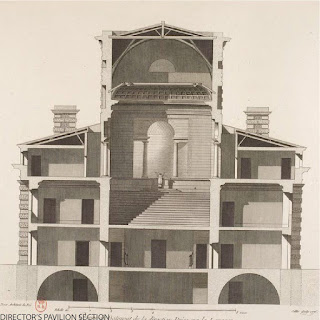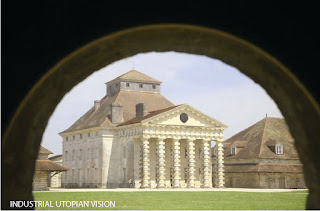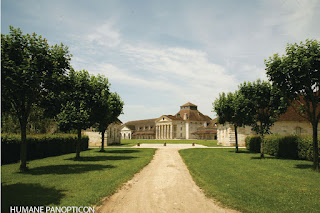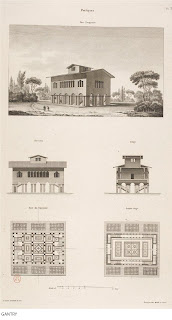"no no.... i really think this is great."
i've been accused idol worship before. liking buildings because they were designed by famous architects. to a layperson, the crumbling concrete block walls and asphalt shingled roofs looked like a dump. surely this was not deserving of a 2 hour drive to visit. or was it?
i made a valiant attempt to defend Lou Kahn's honor.
I now started pointing around the various features of the building in a very excited manner.
“the narrow zones provide the square corner piers for entry storage and toilets and skylit rectangular servant zones for changing showering and washing. Kahn honors the hollow square cmu ‘columns’ by capping them with cast in place concrete slab lid like roofs and articulating vertical expansion joint lines at their edges. With the roofs springing from the corners Kahn highlights the inner square focal point of each structure. The roofs seem to hover mysteriously."
my passionate defense fell on deaf ears like a desperate used car salesman's pitch .
k and j were not buying it.
unfazed, I kept trying to proselytize the skeptics. “During the design of the bathhouse, Kahn was smitten with Palladian grids and how to integrate servant and served spaces. “The architect must find a way in which the serving areas of a space can be there, and still not destroy his spaces. He must find a new column, he must find a new way of making those things work, and still not lose his building on a podium,” he said. “Like the great Villa rotunda, where the servant spaces complement the central roof, here the Trenton bath house uses the same organizational and geometric logic."
 |
| palladian house grids |
 |
| villa rotunda vs trenton bathhouse |
J brutally cut through all my gesticulations and jargon down with his teenage take. "i can't believe we drove 2 hours to see a bathroom." at 13 years old, he has a concept of what kids normally do with their fathers. play baseball or board games, fix fences, go fly fishing, change motor oil. driving 90 minutes to see a bathroom in cornhole new jersey is not what he considers normal father son behavior.
i interrupted his "why are we here?" grievances by dispatching him to the urinal, "you should probably go pee and try to develop a sensitivity to great architecture. hopefully one day, you’ll appreciate these experiences…”
it was sweltering. 95 degrees and humid. i never dress up, but here i was wearing a dress shirt. the night before, i worried that i wouldn't be able to take pictures or videos here since using cameras in bathrooms is kind of dicey with people in various states of deshabille and associated privacy issues.
if caught, i was thinking how awkward the interrogations would be.
"why are you video recording a changing room?"
"for the architecture, sir...”
so i hatched a cockamamie plan. i put on a dress shirt with a front chest pocket. i slid my phone with lens poking out right above the brim and pressed video record. i walked around my apartment slow and steady to practice creating architecture video walkthroughs.
there have been times, where i've gone to sites that don't allow photos only to make secret bootleg videos as the security inevitably looks away. The videos sit in my hard drive like taxidermy shoulder mounts on a hunter's cabin wall. my most treasured kills have included forbidden scenes of the salk institute, frick museum, rockefellers’ estate, last supper, sistine chapel, massacio frescos, etc...
nothing was going to deter me from capturing the essence of the trenton bath house for my handful of dedicated blog readers.
anticipating "sir, no photography in the bathhouse. And absolutely no videotaping in the changing rooms." i pressed record and put my phone in my pocket with the camera peeping out. i walked around more deliberately and slowly so as to keep the lens level. There is nothing worse than going to a site, and not being able to take pictures.
to my disappointment, some middle-aged man was in the changing room putting his clothes on, marring my pristine video frames. i didn't want to look suspicious so i walked nonchalantly over to the urinal and started taking a piss. i left and circled the building for 10 minutes. Within the 9 square plan, the four corners and center are voids. You enter the central open air atrium from a corner. A reception desk fronts a square storage volume capped with a pyramidal roof. On either side of the atrium are the men's and women’s changing rooms which are also sheltered under pyramidal roofs. Opposite the reception in this bilaterally symmetrical arrangement is a ceremonial set of stairs leading up to the municipal pool. This set of stairs has a roof, but no walls. In this way kahn worked between solid and void.
When I returned to the locker room, I incredulously saw the same guy still in the process of putting on his shirt. my luck, i encounter a man in the changing room who fumbles buttons and can’t dress in a reasonably prompt manner.
he probably would've reported me to security if i started filming him overtly. every time i went in, i went to the urinal and peed a little more. i did this about 4 subsequent times at 5 minute intervals each. I have several outtakes on my hard drive of my trenton bath urinations as a result. on my last round, he finally left and i had the room to myself. i promptly took my camera out of my pocket and started filming the roof, and the iconic moments of sky over the showers and sinks. what a grand feeling of openness Kahn provided for those changing to go to the pool.
Despite being in the presence of great architecture I couldn’t stop thinking that the guy who I thought was the slowest dresser, probably thought i had the smallest bladder. and if i were endowed with faulkner's talent, i could write a novel ala 'as i lay dying' where the narrative perspective would stream of consciousness flip back and forth between him, the local slow dressing Trenton resident and me, the sweaty small bladdered architecture enthusiast in dress shirt.
As I lay Waiting for Man to Finish Changing (Chapter 1)
"what's he doing here all dressed up?”
"great, he's the only one in here, i'll feign use of the facilities so as to not act suspicious"
"glad he's gone... I don’t like putting clothes in with other people around. Uh oh… now he's back again"
"shit he's still here, i'm going to force myself to go pee again"
"why is that dude walking around with a phone in his front pocket?"
"this guy literally takes 20 minutes to put on a stupid shirt"
"i feel sorry for this guy. he's sweating and peeing a lot"
and so on and so forth..
I was the perverted dude in dress shirt standing in bathhouse front-pocket filming on the sly. I rationalized to myself, in today's cancel culture. what i was doing was rather harmless.
kahn would've never survived trenton if it were built in today's cultural climate. Pritzker prize winner Richard meier was recently taken down by five women, four of whom were former employees. they came forward with accusations of sexual harassment that included Meier groping their underwear and exposing himself to them. this seems tame to kahn's philandering 50's. Whereas Meier had to renounce his role at his firm and retire ignominiously, during the Trenton project, kahn had a wife, lived with his parents-in-law, had a hustle, and then a side hustle. that is, while Lou kahn raised a daughter with his wife, he simultaneously collaborated with mistress Anne Tyng on the geometry of the Trenton bath house. While Tyng carried Lou’s love child to term in secret in Rome, Kahn engaged in a side hustle with Marie Kuo, an intern working out the bath house entry mural which was based on the baths of Caracalla mosaics. After Tyng returned, Kuo, who didn’t realize Tyng was fluent in Chinese and could understand Kuo’s phone conversations to her mom concerning contraception and was aware of all of Kahn’s transgressions.
within the chaos of his personal life where he juggled 3 children from 3 women and an intern mural designer, Kahn conceived the purest of crystal structures. ideal perfection harmonizing ancient proportions with the integration of servant and served spaces. he made his architecture extra logical, legible and clear to counterbalance the chaos of his personal life.
While all these relationships were consensual, Kahn probably wielded his position of power to gain access to these women. Without cancellation, Kahn went on to design some of the world’ greatest buildings: the kimbell arts museum, salk institute, exeter library, british arts center.... similar in depravity, frank lloyd wright went on to design the guggenheim, usonian houses, falling water, taliesin I and II after running off with a client's wife and being caught moonlighting in louis sullivan's firm. jefferson designed UVA and monticello after serially impregnating his deceased wife’s half sister and daughter’s teenage slave/companion Sally Hemmings. Philip Johnson supposedly burned all his nazi white supremacist papers in the chimney of the glass house, etc.. many great architects did amazing work with very questionable morals. That is, the history of great architecture is constituted by the stunning work of socially deviant architects who refuse to submit to societal norms.
Comparing Trenton to his last project, the Yale British arts center, one can see how kahn developed and evolved themes of servant-served, day light modulation, and building planning principles.
At Trenton, Kahn refined his approach to utilitarian spaces and articulated his notion of spaces serving and spaces served. Whereas each pyramidal asphalt shingled wood roof at Trenton rests on four hollow CMU column supports that serve as mechanical spaces or as circulation for changing room, in his British Arts Center, his blackened steel-clad columns and precast beam supports were hollow and served as mechanical spaces to convey air, electricity, and water. servant space is woven seamlessly into served space, articulated and harmonious.
At the BAC, Kahn continued the Trenton truncated pyramidal roof lighting motif but increased the aperture size and introduced louvers for a more diffuse filtered lighting suitable for artwork. Kahn figured out ways to control direct sun by adding layer of sunscreening devices.
finally, the trenton bathouse was supposed to be part of a larger complex never built that Kahn envisioned for a jewish community center that included a landscape of axial pathways on tree lined paths, and a day camp pavilion. Kahn developed notions of how buildings and space are organized in relation to each other. Spatially, at Trenton, each bathhouse room is conceived as an independent pavilion around a central atrium, which is open to the sky. In BAC, each gallery room is similarly conceived as a skylit gallery cell that surrounds a daylit central entry atrium, and double height picture gallery.


.jpg)












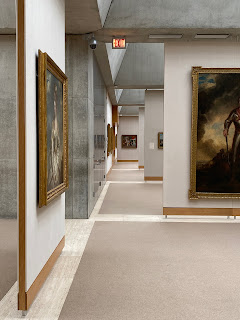















.jpg)
.jpg)

































